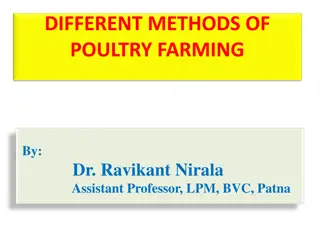Evolution of Livestock-based Livelihoods and Capitalistic Farming Systems
Livestock-based livelihoods have evolved over time, with capitalistic farming systems emerging as prominent in regions like South America, North America, and Europe. These systems are characterized by individual entrepreneurs controlling farming activities. Plantations are a common example of capitalistic farming, often owned by foreigners and exporting processed products. While capitalistic farming offers economic freedom and efficient resource use, it also presents challenges such as low living standards for farm workers.
Download Presentation

Please find below an Image/Link to download the presentation.
The content on the website is provided AS IS for your information and personal use only. It may not be sold, licensed, or shared on other websites without obtaining consent from the author.If you encounter any issues during the download, it is possible that the publisher has removed the file from their server.
You are allowed to download the files provided on this website for personal or commercial use, subject to the condition that they are used lawfully. All files are the property of their respective owners.
The content on the website is provided AS IS for your information and personal use only. It may not be sold, licensed, or shared on other websites without obtaining consent from the author.
E N D
Presentation Transcript
UNIT-01 (LIVESTOCK BASED LIVELIHOODS AND THEIR EVOLUTION) Dr. Puspendra Kumar Singh Department of Veterinary & Animal Husbandry Extension Education, BVC
Capitalistic Farming In Capitalistic farming system, farming activities are controlled and manipulated by individual entrepreneurs. Capitalistic farming system is predominant in South America, North America and Europe. Prominent aspects of capitalistic management exist in the world. Some examples of capitalistic management include farming corporations in North America, the agro-industrial Konbinats in Eastern Europe and ranches in South America.
Plantation is the commonest example of capitalistic farming, It is generally observed in developing countries in the world. Perennial crops (Crops lasting for three seasons or more) are produced through plantation farming. In most of the cases, plantations are owned by foreigners. The distinguishing attribute of plantation is that the end products of plantation are processed in their own plants and finally exported to the foreign countries.
Top level efficient personnel are employed in plantation management, characterized by strict power and well organized work structure. Therefore the productivity always remains very high. Despite being controlled by foreigners, the domestic countries also reap benefits from export taxes. In capitalistic farming system, the farm workers maintain a very low standard of living.
MERITS AND DEMERITS OF CAPITALISTIC FARMING SYSTEM
The main merits of this system are: Economic Freedom: (i) One can spend one s income according to one s wishes. Producers have complete freedom to invest. (ii) Automatic Working: Equilibrium point is automatically come with the forces of demand and supply. (iii) Variety of Goods and Services: All the basic decisions of what to produce, how to produce and for whom to produce are taken by producers. Every producer gives attention to consumers taste and preferences. (iv) Optimum Use of Resources: All resources are used efficiently as production is undertaken with a sole purpose: of earning profit.
(v) Efficient Producer: There is very tough competition among entrepreneurs. They always encouraged to produce best quality of products. It leads to higher productivity & efficiency. (vi) Higher Standard of Living: Varieties of goods at cheap rates make it easy to be within the; reach of poor and weaker sections of society. This results in rise in their standard of living. (vii) Incentive to efficient: In this system, incentives are given to the efficient workers in cash or kind. This means every worker should get reward according to his ability. (viii) New Inventions: In this type of economy, there is ample scope of new invention. To get more profit every producer takes initiative to develop new techniques in production.
The main demerits of this system (i) Labour Exploitation: The main defect of capitalism is the exploitation of labour. Labourers get less wages in comparison to their working hours. (ii) Class Struggle: A significant share of income and resources is controlled by the upper sections of the society, while others remain deprived of the basic amenities of life. (iii) Wasteful Competition: Capitalism is a wasteful competition. A lot of money is spent on advertisement and publicity for pushing the sale of the commodity.
(iv) Threat of Over-Production: The production is made on a large scale which cannot be changed in a short period. Therefore, under capitalism, fear of over-production always exists. (v) Economic Fluctuations: Being automatic in nature, capitalist economy always faces the problem of economic fluctuations and unemployment. (vi) No Welfare Activities: In capitalism, the sole motive is maximum profit, but not the public welfare. (vii) Monopoly Practices: This economic system has been criticised on the fact that it develops monopoly activities within the country.























